Forest ecosystems are complex, dynamic, self-contained associations of biotic and abiotic factors. It is most prominently dominated by trees, shrubs, and other vegetation and animal groups. Forest ecosystems play a vital role in supporting life on earth because they play an important part in regulating climate, biodiversity conservation, protection of watersheds, and the maintenance of human economies by supplying essential resources to human societies.
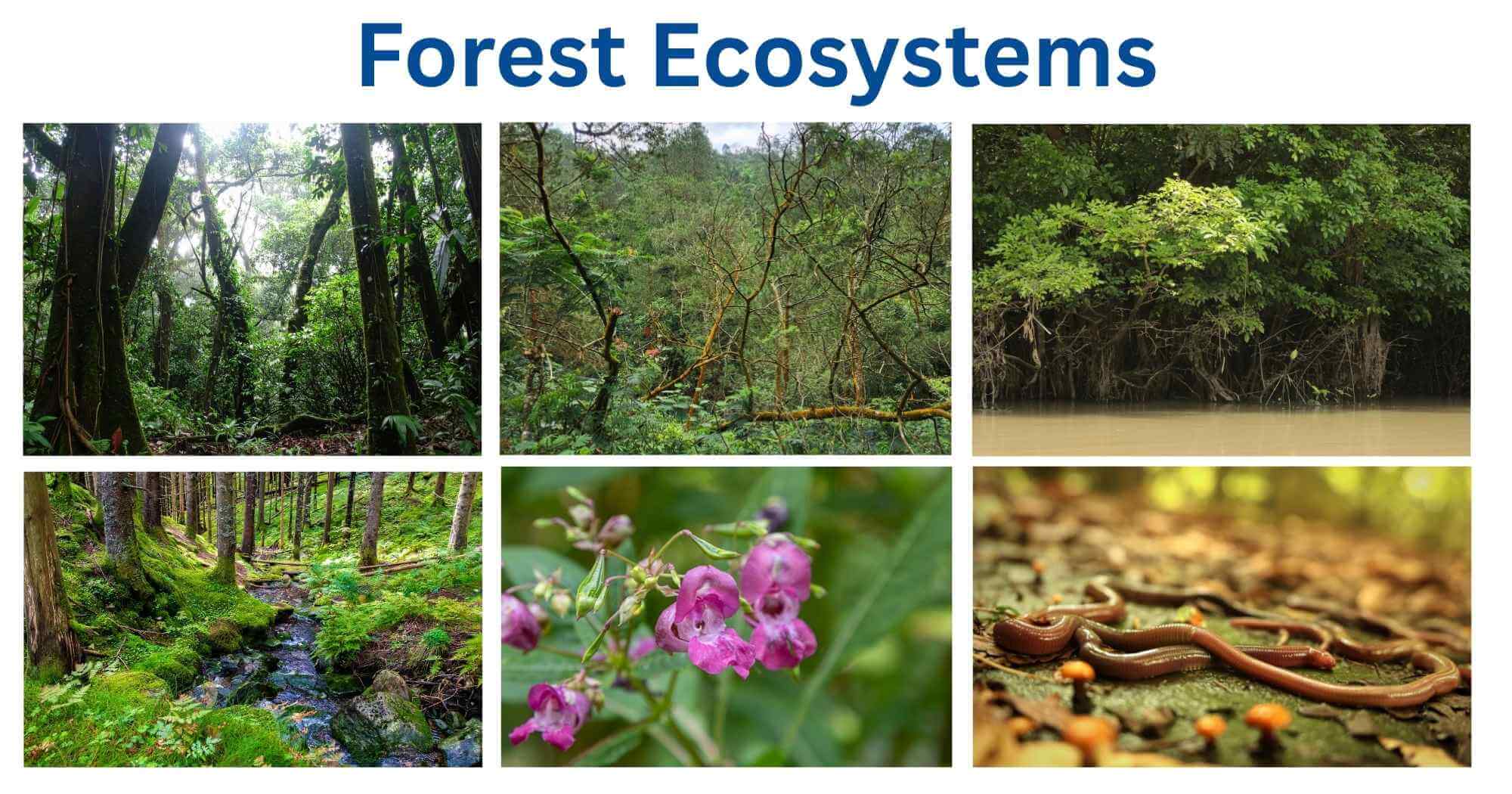
Definition and Significance of Forest Ecosystems
A forest ecosystem is any natural community of living things (plants, animals, microorganisms) that interact with the abiotic factors (climate, soil, water) in a forest environment.
The importance of forest ecosystems is that they are multi-functioning i.e. they maintain the balance between atmospheric gases such as oxygen, and carbon dioxide and also balance hydrological cycles, prevent erosion, increase biodiversity, provide raw materials such as timber and medicinal herbs, and offer cultural and recreational space for human beings.
Forests are also referred to as “the lungs of the Earth” due to oxygenation and control of atmospheric gases.
Global Distribution of Forest Ecosystems
About 31% of the Earth’s surface is covered by a forest ecosystem that accounts for about 4.06 billion hectares. Forests are not evenly spread over the earth, but they have the widest continuous expanses in tropical regions such as the Amazon Basin, in the boreal regions such as Siberia, and temperate regions such as the eastern United States and Europe.
Tropical forests predominate close to the equator, boreal forests cover high northern latitudes, and temperate forests occur between the tropics and poles. Russia, Brazil, Canada, the United States, and China are some of the countries with the highest forest cover.
Types of Forest Ecosystems
Forests differ according to geographical location, climate, altitude, and soil. Depending on these, forests have been categorized into various types:
Tropical Rainforests
Tropical rain forests are located in places close to the equator like the Amazon Basin (South America), the Congo Basin (Africa), and Southeast Asia. Tropical rainforests are characterized by high rainfall (in excess of 2000 mm annually) and uniform warm temperatures (25–30°C). Tropical rainforests are the most ecologically complicated systems on our planet and are home to a high percentage of all plant and animal species presently described.
Some of the notable features are dense cover, multi-layer canopy, impoverished nutrient soils due to excessive decomposition processes, and a large population of big trees such as Dipterocarpus species and Ceiba pentandra (kapok tree).
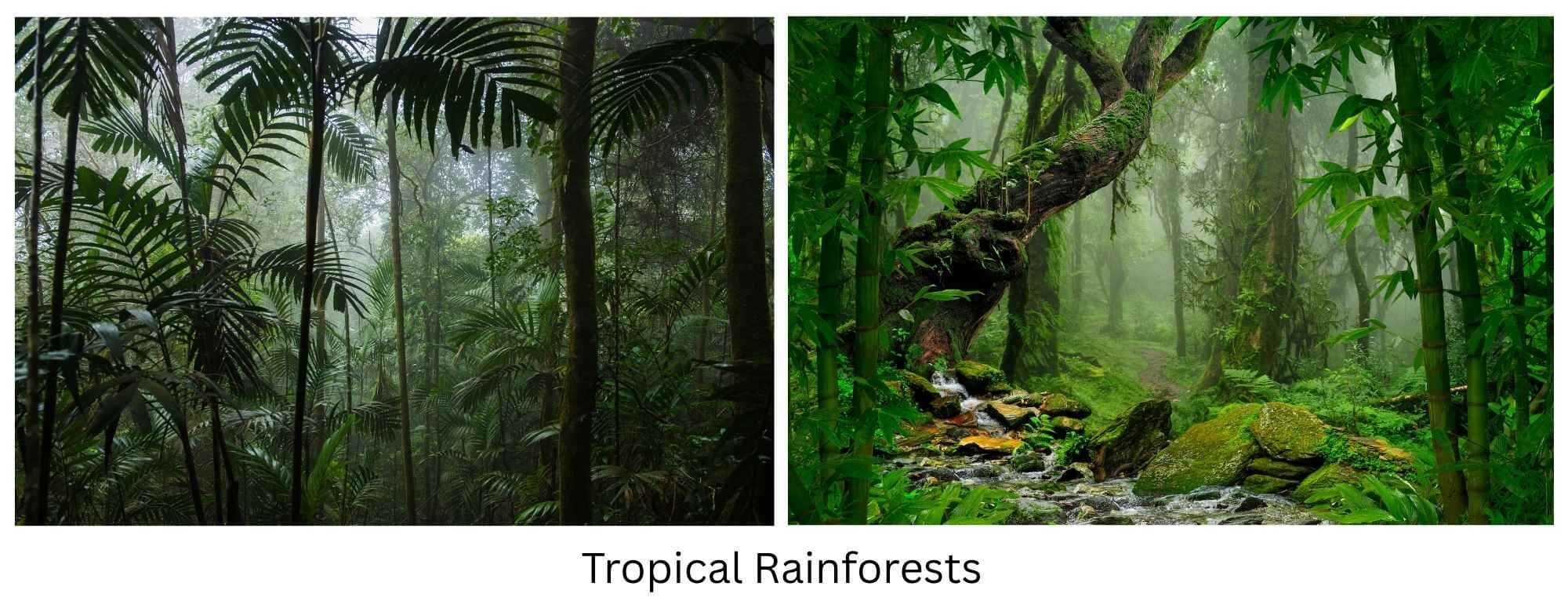
Temperate Deciduous Forests
Temperate deciduous forests occur in areas with four distinct seasons, such as parts of Europe, North America, and East Asia. Trees from these forests drop their leaves each year in autumn as a mechanism for conserving water during the winter season. Rain is moderate and distributed uniformly throughout the year.
It has common tree species such as oaks (Quercus robur), maples (Acer saccharum), beeches (Fagus sylvatica), and hickories (Carya ovata). The forests harbor a variety of animal species, such as deer, foxes, and other bird species.
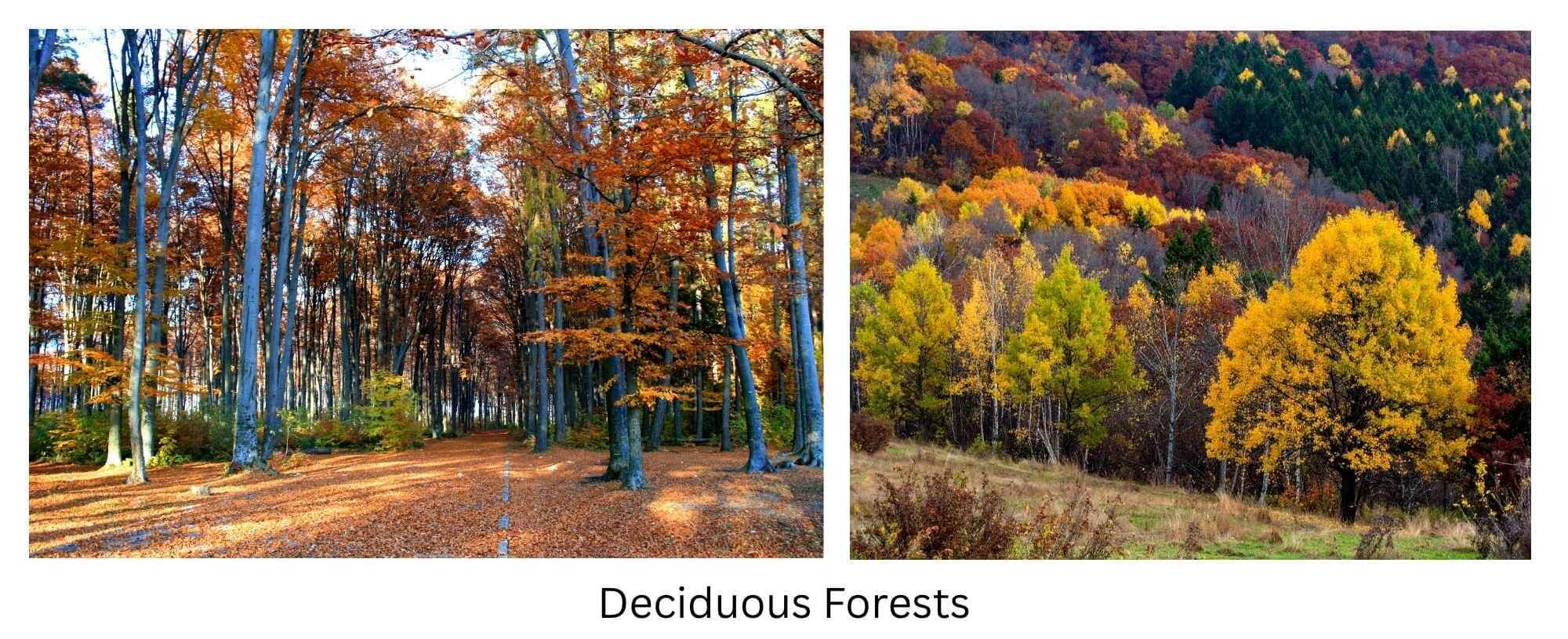
Boreal (Taiga) Forests
The Taiga, or boreal forests, occur in the high northern latitudes, i.e., Canada, Russia, Scandinavia, and Alaska. They constitute the largest terrestrial biome on the Earth. Boreal forests have long, cold winters and short, mild summers.
The forests are characterized by coniferous trees like spruces (Picea abies), firs (Abies balsamea), and pines (Pinus sylvestris) and are suited to cold temperatures and acidic, nutrient-scarce soils. Boreal forests play a very critical role in sequestering carbon globally but are strongly climate-sensitive and flammable.
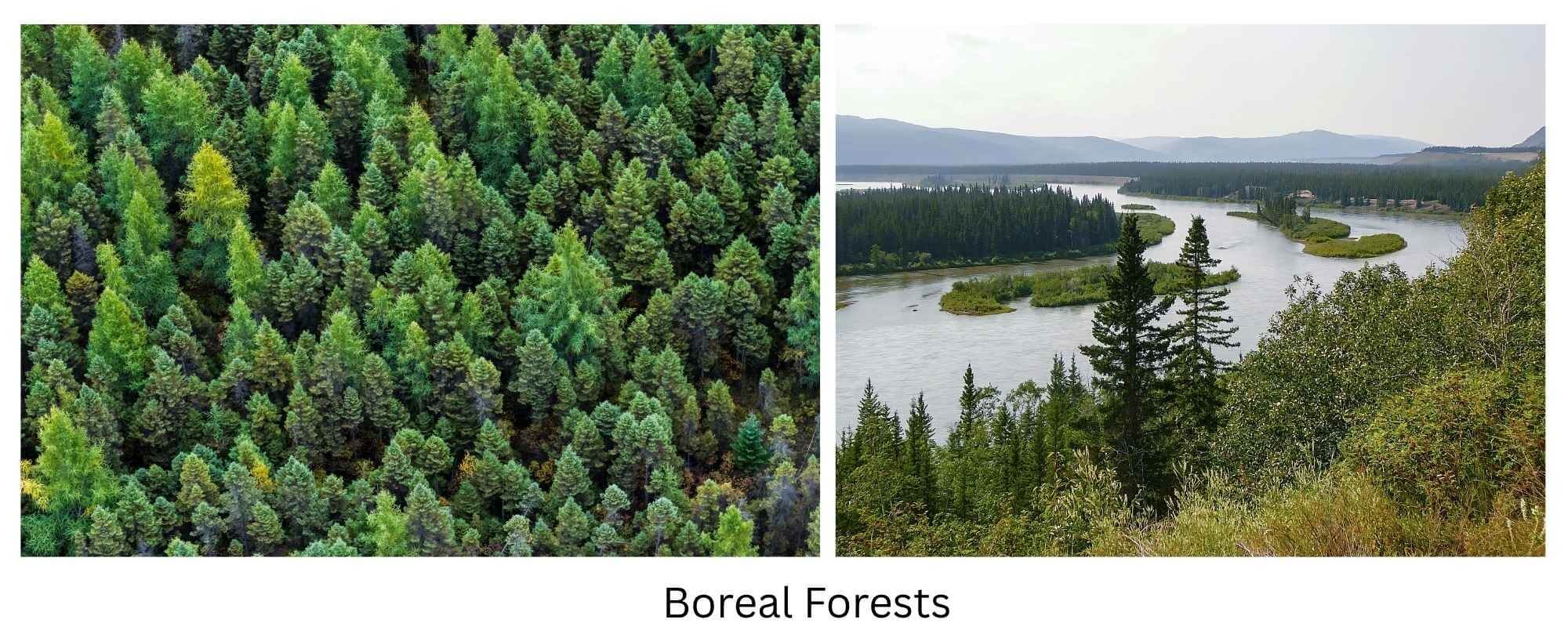
Montane and Mangrove Forests
Montane Forests: These are forests at mountainous elevations and vary by elevation. Lower montane forests resemble tropical rainforests, while the higher montane forests (also called cloud forests) are cooler, misty, and have mosses and lichens. Examples include the Andean forests and the Himalayan montane forests, with Podocarpus and Weinmannia being examples.
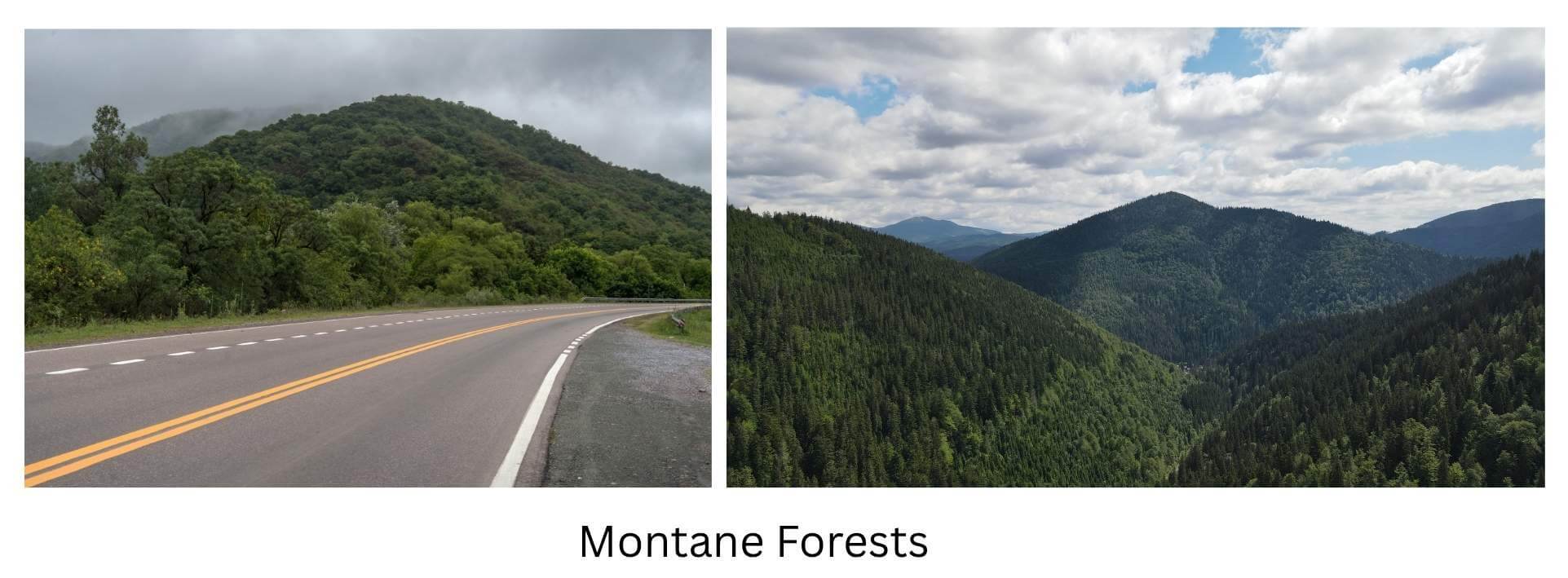
Mangrove Forests: Mangrove forests occur on tropical and sub-tropical coasts and are suited to brackish or saline water environments. They have salt-tolerant species such as Rhizophora mangle (red mangrove) and Avicennia marina (grey mangrove). Mangrove forests play critical roles in coastal protection, erosion control, marine nurseries, and carbon storage.
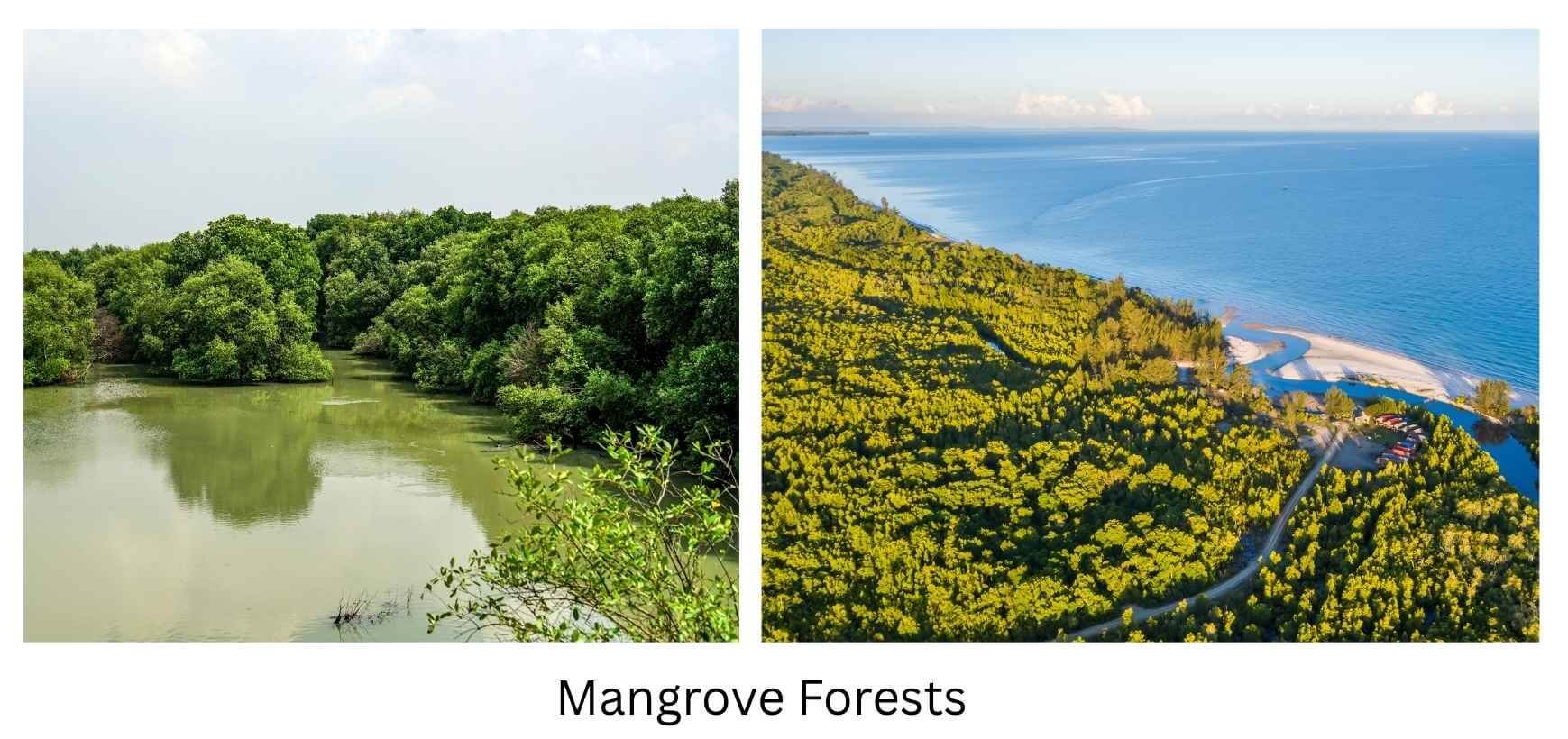
Structural components of Forest Ecosystems
Forest ecosystems are not static but are dynamic systems with multiple layers of structure and interacting biological and physical components. The structures and components interact together to form an active environment in which an extraordinary diversity of life organisms thrive. The various layers of the forest include-
Canopy Layer
The canopy is the highest layer of a forest, made up of the crowns of tall trees that usually create a close, unbroken cover. The canopy captures most of the sunlight, regulates microclimate conditions underneath, and provides shelter for a diversity of species, such as epiphytes, birds, and forest mammals. Shorea robusta (sal tree) and Dipterocarpus alatus are some examples of canopy trees.
Understory Layer
Below the canopy, the understory is exposed to very little light and is dominated by shade-tolerant plants like shrubs, saplings, and herbaceous plants. Plants like Psychotria (wild coffee) and Calathea species thrive here and provide insects, reptiles, and small mammals with shelter and food.
Forest Floor Layer
Forest floor is the lowest layer with minimal sunlight. It is composed of high densities of decomposing plant material like leaves, wood, and dead animals with high densities of nutrients. Fungi (like Agaricus bisporus) and detritivores like earthworms are responsible for decomposition and nutrient cycling in this instance.
Biotic Components
Flora: The forest vegetation is very rich and consists of trees, shrubs, herbs, climbers, ferns, and mosses. They consist of many plants such as Tectona grandis (teak), Cedrus deodara (deodar cedar), and Ficus religiosa (peepal tree).
Fauna: Fauna of the forest includes mammals, birds, reptiles, amphibians, insects, and microorganisms. Important species include Panthera tigris (tiger), Gorilla gorilla (western gorilla), Ara macao (scarlet macaw), and Python reticulatus (reticulated python).
Abiotic Components
Soil: Forest soils are diverse but are inclined to harbor a high variety of organisms and act as the substrate for plant growth. Tropical forest laterite soils and boreal forest podzol soils are common examples.
Water: Forests control a significant fraction of the global water cycle. Forests receive rainfall, store it, distribute water to regulate groundwater recharges, and maintain river discharges. The wooded wetlands, for example, are equivalent to natural sponges because they absorb water slowly and allow water to go off slowly.
The temperature, rain, moisture, and light set the type and productivity of the forest system. Tropical rainforests thrive when it’s hot and warm weather and also bear forests will manage cold dry seasons.
Forest Biodiversity
Forests are among the most biologically diverse systems on earth, hosting more than 80% of the land organisms.
Plant diversity and adaptations
Plant adaptations to survive in their respective habitats are:
Buttress Roots: Tropical trees like Ceiba pentandra, for support in shallow soils.
Epiphyte: Tillandsia usneoides (Spanish moss) and other orchid plants grow on other plants to obtain light without damaging their hosts.
Needle-shaped leaves: Present in conifers like Picea abies (Norway spruce), minimizing water loss during cold or dry conditions.
Animal species and their roles in ecology
Various Animal species play an important role in ecology, some of which are discussed below:
Pollinators: Apis mellifera (honeybee) and Danaus plexippus (monarch butterfly) aid in plant reproduction.
Seed Dispersers: Ramphastos toco (toco toucan) birds and Pongo pygmaeus (rang-utan) mammals help plant propagation.
Predators and Prey: Panthera leo (lion) carnivores and Odocoileus virginianus (white-tailed deer) herbivores control populations thereby keeping the ecosystem in balance.
Microorganisms and Decomposers
Microorganisms like bacteria (Rhizobium spp.) and fungi (Penicillium spp.) perform vital functions in decomposition and nutrient cycling. Microorganisms decompose complex organic matter into simpler, plant-consumable forms allowing life processes to continue in the forest.
Ecological Functions and Services of Forest Ecosystems
Forests provide many ecological services essential to nature and human society:
Carbon Sequestration and Climate Regulation– Trees take up atmospheric carbon dioxide and store carbon, slowing global warming. Tropical rainforests such as the Amazon are vast carbon sinks.
Soil conservation and regulation of the water cycle– Forests stabilize the rain regime, avert soil erosion via root systems entrapping, and allow groundwater recharge. Land covered with forests will turn into deserts and record declining agricultural outputs if deforested.
Provision of habitat– Forests serve as refuge, diet, and breeding sites for tens of millions of species, enabling complex food webs and ecological balance.
Human Impact on Forest Ecosystems
The forest is in severe danger from numerous human activities which are as follows-
Deforestation and Habitat Fragmentation
Deforestation, often caused by agricultural encroachment, logging, and urbanization, is the permanent removal of forest cover. Brazil and Indonesia have suffered large-scale forest loss, especially in the tropics. Habitat fragmentation happens when forests are broken into patches, separating species populations and interfering with ecological processes. This results in decreased genetic diversity decreased survival rates of species, and changed microclimates.
Pollution and Introduction of Alien Species
Forests are also being increasingly affected by pollution from industrial processes, agriculture, and urbanization. Sulfur dioxide and nitrogen oxides in the atmosphere result in acid rain, which destroys vegetation and soil chemistry. Aquatic life in the forest ecosystem is harmed due to water pollution. Invasive alien species, Lantana camara, and Acacia mearnsii tend to shade out native vegetation, modify habitat structure, and threaten the extinction of native species.
Climate Change Impacts on Forest Health
Climate change exacerbates other forest threats. Increased temperatures, changed precipitation, and extreme weather events (e.g., droughts and hurricanes) stress forest systems.
For instance, boreal forests are experiencing rising cases of fires and infestation by insects (e.g., Dendroctonus ponderosae, mountain pine beetle). Such occurrences not only diminish the biodiversity and health of the forests but also diminish the forests’ ability to sequester carbon, which creates a feedback mechanism that makes global warming escalate.
Conservation and Sustainable Use of Forest Ecosystems
Given the vital significance of forests, a variety of methods have been established to protect and utilize them in a sustainable way.
Protected Areas
The establishment of national parks, wildlife sanctuaries, and biosphere reserves helps safeguard priority forest ecosystems. The Amazon Rainforest Reserves and the Sundarbans Biosphere Reserve are good examples. These protected areas provide legal guidelines to prevent exploitation and encourage the conservation of biodiversity.
Reforestation and Afforestation
Reforestation refers to the act of growing trees where forest cover previously stood but no longer exists, and afforestation means growing trees where there were previously no forests. Internationally, initiatives like the Bonn Challenge and the Trillion Trees Campaign are committed to restoring millions of hectares of forest cover, and thus improving biodiversity, soil stabilization, and climate change prevention.
Community-Based Forest Management
Community-Based Forest Management (CBFM) is a people-oriented system by which the local people themselves play an active role in forest resource management, conservation, and sustainable use of forests. Rural communities and local indigenous communities gain from this system through their native experience and deep roots in the area. A few such examples are Nepal’s Community Forestry program and India’s Joint Forest Management (JFM) schemes. CBFM has also been found to enhance the forest cover, enhance the conservation of biodiversity, and promote livelihood opportunities as a result of sustainable harvesting of forest non-wood products such as fruits, medicinal herbs, and resin.
Benefits of CBFM include:
Increased local responsibility and stewardship,
Reduced illegal logging and deforestation,
Enhanced socio-economic well-being of individuals living within the forest,
International Initiatives and Agreements
The protection of forests across the world is managed by several influential global programs and agreements:
The United Nations Forum on Forests (UNFF): A website promoting the management, preservation, and sustainable development of all forest types worldwide.
The REDD+ Program (Reducing Emissions from Deforestation and Forest Degradation): Under the UNFCCC, REDD+ offers incentives to developing nations for keeping forests intact and stockpiling carbon stocks.
The Convention on Biological Diversity (CBD): An international agreement ensuring biodiversity globally, including forest ecosystems.
The Paris Agreement: Forest conservation has also been identified as an important means to attain climate targets, and a large number of countries include forest conservation within their nationally determined contributions (NDCs).
These global instruments ensure support of funds, transfer of technology, building capacity, and policy support for forest conservation at the global level.
The Future of Forest Ecosystems
The destiny of forest ecosystems will be influenced mainly by the way human beings handle existing problems. If deforestation, habitat loss, and global warming proceed with no limitation, forests will undergo extreme degradation, resulting in the loss of biodiversity and ecosystem services vital to life on our planet.
But with increased awareness, technological advancement (e.g., satellite imaging and AI-conservation software), afforestation efforts, and increased global collaboration, forests can be restored and conserved. Green option prioritization, green industry promotion, and inclusive governance mechanisms can help to increase the resilience of forest landscapes.
Some of the major directions for the future can be:
Urban forest cover and green corridors expansion,
Increased Indigenous knowledge integration in forest management
Enhanced global policies on ecosystem restoration (e.g., UN Decade on Ecosystem Restoration 2021–2030),
Increased climate change mitigation through forests,
Conclusion
Forest ecosystems are invaluable natural resources that sustain life on earth through the provision of important ecological services, maintain biodiversity, regulate climate, and cater to the health of human beings. However, they are undergoing unprecedented risk owing to the impacts of human actions and climate change. Ensuring their conservation and regeneration is necessary through conservation, sustainable use, involvement of local communities, and effective international action.
By valuing forests not just for what they can give but also for what they are ecologically worthy of themselves, human civilization can create a more sustainable and peaceful world wherein forests could continue to exist for centuries.
References
- The Editors of Encyclopaedia Britannica. (2025, April 26). Forest | Definition, Ecology, Types, Trees, Examples, & Facts. Encyclopedia Britannica. https://www.britannica.com/science/forest
- EcoMatcher, B. F. C. (2024, November 30). Everything you need to know about the types of forests. Medium. https://ecomatcher.medium.com/everything-you-need-to-know-about-the-types-of-forests-a244bf192453
- Klappenbach, L. (2018, September 5). The layers of a forest from floor to canopy. ThoughtCo. https://www.thoughtco.com/structure-of-a-forest-130075
- Testbook. (2023, October 5). Forest Ecosystem – definition, functions, types, components, processes, and characteristics. Testbook. https://testbook.com/biology/forest-ecosystem
- Brockerhoff, E. G., Barbaro, L., Castagneyrol, B., Forrester, D. I., Gardiner, B., González-Olabarria, J. R., Lyver, P. O., Meurisse, N., Oxbrough, A., Taki, H., Thompson, I. D., Van Der Plas, F., & Jactel, H. (2017). Forest biodiversity, ecosystem functioning, and the provision of ecosystem services. Biodiversity and Conservation, 26(13), 3005–3035. https://doi.org/10.1007/s10531-017-1453-2
- Daba, M. H., & Dejene, S. W. (2018). The Role of Biodiversity and Ecosystem Services in Carbon Sequestration and its Implication for Climate Change Mitigation. juniperpublishers.com. https://doi.org/10.19080/IJESNR.2018.11.555810
- Forests and climate change. (n.d.). IUCN. https://iucn.org/resources/issues-brief/forests-and-climate-change
- ESS Subtopic 3.2: Human Impact on Biodiversity. (n.d.). AMAZING WORLD OF SCIENCE WITH MR. GREEN. https://www.mrgscience.com/ess-subtopic-32-human-impact-on-biodiversity.html
- Climate change impacts on forests | US EPA. (2025, March 3). US EPA. https://www.epa.gov/climateimpacts/climate-change-impacts-forests
- Maraseni, T. N., Cockfield, G., & Apan, A. (2005). Community based forest management systems in developing countries and eligibility for the CDM. ResearchGate. https://www.researchgate.net/publication/239922650_Community_Based_Forest_Management_Systems_in_Developing_Countries_and_Eligibility_for_the_CDM
- International Initiatives – Unacademy. (2022, February 26). Unacademy. https://unacademy.com/content/kerala-psc/study-material/science-technology/international-initiatives/
